
Aleuts are the Indigenous people of the Aleutian Islands, which are located between the North Pacific Ocean and the Bering Sea. Both the Aleuts and the islands are politically divided between the US state of Alaska and the Russian administrative division of Kamchatka Krai. This group is also known as the Unangax̂ in Unangam Tunuu, the Aleut language. There are 13 federally recognized Aleut tribes in the Aleut Region of Alaska. In 2000, Aleuts in Russia were recognized by government decree as a small-numbered Indigenous people.
Eskimo is an exonym that refers to two closely related Indigenous peoples: Inuit and the Yupik of eastern Siberia and Alaska. A related third group, the Aleut, who inhabit the Aleutian Islands, are generally excluded from the definition of Eskimo. The three groups share a relatively recent common ancestor, and speak related languages belonging to the family of Eskaleut languages.

From 1732 to 1867, the Russian Empire laid claim to northern Pacific Coast territories in the Americas. Russian colonial possessions in the Americas were collectively known as Russian America. It consisted mostly of present-day Alaska in the United States, but also included the outpost of Fort Ross in California. Russian Creole settlements were concentrated in Alaska, including the capital, New Archangel, which is now Sitka.
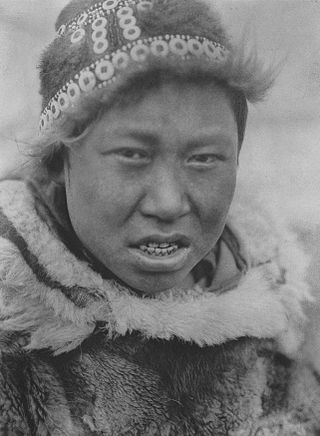
The Yupik are a group of Indigenous or Aboriginal peoples of western, southwestern, and southcentral Alaska and the Russian Far East. They are related to the Inuit and Iñupiat. Yupik peoples include the following:

The Eskaleut, Eskimo–Aleut or Inuit–Yupik–Unangan languages are a language family native to the northern portions of the North American continent, and a small part of northeastern Asia. Languages in the family are indigenous to parts of what are now the United States (Alaska); Canada including Nunavut, Northwest Territories, northern Quebec (Nunavik), and northern Labrador (Nunatsiavut); Greenland; and the Russian Far East. The language family is also known as Eskaleutian, or Eskaleutic.
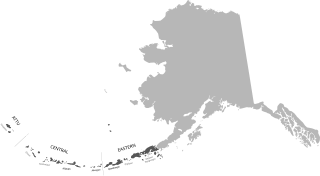
Aleut or Unangam Tunuu is the language spoken by the Aleut living in the Aleutian Islands, Pribilof Islands, Commander Islands, and the Alaska Peninsula. Aleut is the sole language in the Aleut branch of the Eskimo–Aleut language family. The Aleut language consists of three dialects, including Unalaska, Atka/Atkan, and Attu/Attuan.

Siberian Yupiks, or Yuits, are a Yupik people who reside along the coast of the Chukchi Peninsula in the far northeast of the Russian Federation and on St. Lawrence Island in Alaska. They speak Central Siberian Yupik, a Yupik language of the Eskimo–Aleut family of languages.
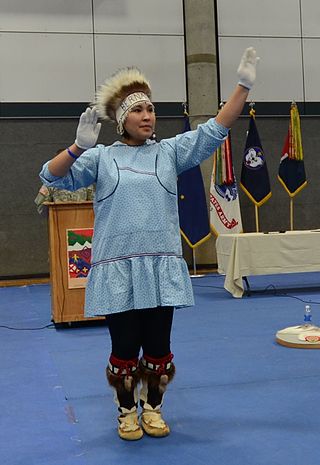
Alaska Natives are the Indigenous peoples of Alaska and include Russian Creoles, Iñupiat, Yupik, Aleut, Eyak, Tlingit, Haida, Tsimshian, and a number of Northern Athabaskan cultures. They are often defined by their language groups. Many Alaska Natives are enrolled in federally recognized Alaska Native tribal entities, who in turn belong to 13 Alaska Native Regional Corporations, who administer land and financial claims.
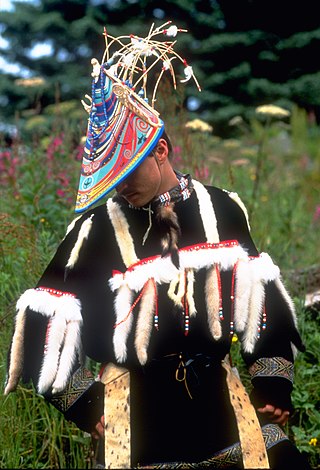
The Alutiiq, also called by their ancestral name Sugpiaq, as well as Pacific Eskimo or Pacific Yupik, are a Yupik peoples, one of eight groups of Alaska Natives that inhabit the southern-central coast of the region.

The Yupik languages are a family of languages spoken by the Yupik peoples of western and south-central Alaska and Chukotka. The Yupik languages differ enough from one another that they are not mutually intelligible, although speakers of one of the languages may understand the general idea of a conversation of speakers of another of the languages. One of them, Sirenik, has been extinct since 1997.

Prehistoric Alaska begins with Paleolithic people moving into northwestern North America sometime between 40,000 and 15,000 years ago across the Bering Land Bridge in western Alaska; a date less than 20,000 years ago is most likely. They found their passage blocked by a huge sheet of ice until a temporary recession in the Wisconsin glaciation opened up an ice-free corridor through northwestern Canada, possibly allowing bands to fan out throughout the rest of the continent. Eventually, Alaska became populated by the Inuit and a variety of Native American groups. Trade with both Asia and southern tribes was active even before the advent of Europeans.

A tuilik is an Inuit watertight jacket, used when paddling a kayak. It is sealed at the face, at the wrists and around the cockpit coaming. In this way the paddler can capsize and come back upright without getting wet, and without getting any water into the kayak.

The Yupʼik or Yupiaq and Yupiit or Yupiat (pl), also Central Alaskan Yupʼik, Central Yupʼik, Alaskan Yupʼik, are an Indigenous people of western and southwestern Alaska ranging from southern Norton Sound southwards along the coast of the Bering Sea on the Yukon-Kuskokwim Delta and along the northern coast of Bristol Bay as far east as Nushagak Bay and the northern Alaska Peninsula at Naknek River and Egegik Bay. They are also known as Cupʼik by the Chevak Cupʼik dialect-speaking people of Chevak and Cupʼig for the Nunivak Cupʼig dialect-speaking people of Nunivak Island.
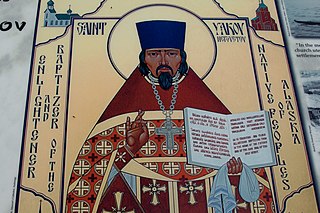
Jacob Netsvetov, Enlightener of Alaska, was an Alaskan Creole from the Aleutian Islands who became a priest of the Orthodox Church and continued the missionary work of Innocent for Alaska Natives. His feast day is celebrated on July 26, the day of his death.
Alaska Natives are a group of indigenous people that live in the state of Alaska and trace their heritage back to the last two great migrations that occurred thousands of years ago. The Native community can be separated into six large tribes and a number of smaller tribes, including the Iñupiat, Yup'ik, Aleut, Tlingit, Haida, Tsimshian, and others. Even with just a small number of communities that make up the entire population, there were more than 300 different languages that the Natives used to communicate with one another.

A kuspuk is a hooded overshirt with a large front pocket commonly worn among Alaska Natives. Kuspuks are tunic-length, falling anywhere from below the hips to below the knees. The bottom portion of kuspuks worn by women may be gathered and akin to a skirt. Kuspuks tend to be pullover garments, though some have zippers.

Yup'ik doll is a traditional Eskimo style doll and figurine form made in the southwestern Alaska by Yup'ik people. Also known as Cup'ik doll for the Chevak Cup'ik dialect speaking Eskimos of Chevak and Cup'ig doll for the Nunivak Cup'ig dialect speaking Eskimos of Nunivak Island. Typically, Yup'ik dolls are dressed in traditional Eskimo style Yup'ik clothing, intended to protect the wearer from cold weather, and are often made from traditional materials obtained through food gathering. Play dolls from the Yup'ik area were made of wood, bone, or walrus ivory and measured from one to twelve inches in height or more. Male and female dolls were often distinguished anatomically and can be told apart by the addition of ivory labrets for males and chin tattooing for females. The information about play dolls within Alaska Native cultures is sporadic. As is so often the case in early museum collections, it is difficult to distinguish dolls made for play from those made for ritual. There were always five dolls making up a family: a father, a mother, a son, a daughter, and a baby. Some human figurines were used by shamans.

Yup'ik clothing refers to the traditional Eskimo-style clothing worn by the Yupik people of southwestern Alaska.

Yup'ik cuisine refers to the Inuit and Yup'ik style traditional subsistence food and cuisine of the Yup'ik people from the western and southwestern Alaska. Also known as Cup'ik cuisine for the Chevak Cup'ik dialect speaking Eskimos of Chevak and Cup'ig cuisine for the Nunivak Cup'ig dialect speaking Eskimos of Nunivak Island. This cuisine is traditionally based on meat from fish, birds, sea and land mammals, and normally contains high levels of protein. Subsistence foods are generally considered by many to be nutritionally superior superfoods. Yup’ik diet is different from Alaskan Inupiat, Canadian Inuit, and Greenlandic diets. Fish as food are primary food for Yup'ik Eskimos. Both food and fish called neqa in Yup'ik. Food preparation techniques are fermentation and cooking, also uncooked raw. Cooking methods are baking, roasting, barbecuing, frying, smoking, boiling, and steaming. Food preservation methods are mostly drying and less often frozen. Dried fish is usually eaten with seal oil. The ulu or fan-shaped knife is used for cutting up fish, meat, food, and such.

Unangan hunting headgear are wooden hats associated with the Unangan or Unangas, the Indigenous peoples of what are currently known as the Aleutian Islands.

















